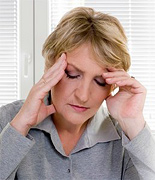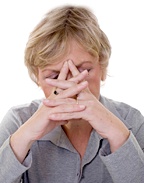Most of us can say we've experienced a headache. My question is: Do you know what type of headache you suffered and the best way to address it naturally?
Headaches are the most self-diagnosed and self-medicated dysfunction in the U.S., with an estimated half-billion dollars spent on headache cures in just the past year. More than 60 million people made a visit to the doctor's office last year because they thought their headache was severe enough to seek treatment, but only 2 percent of these were caused by brain tumors, hypertension or other serious conditions. Although we can differentiate between dozens of headaches, here are the top five, along with a few natural treatment options.
Cluster Headaches
Let's begin with a discussion of vascular headaches. Cluster headaches and migraines both are vascular in nature, which means the headache comes from within the cranium. A cluster headache is a stabbing pain that occurs on one side of the head, and often is local to one temple or behind one eye. These painful attacks occur every day or several times a day for weeks or months, and can last from 15 minutes to three hours.
 Men are more likely to suffer from cluster headaches. The first attack
of a cluster headache usually starts in patients 20-30 years of age.
Heavy smokers are more likely to suffer from cluster headaches, but
unlike migraine headaches, they are not familial (i.e., they do not run
in the family). Although this headache starts behind one eye, it may
radiate into the temple, nose, jaw, chin or teeth. One of the most
common signs is a drooping eyelid, as well as tearing or red eyes on the
side of the headache. Other symptoms include runny or stuffy nose and
facial sweating, which occur on the side of the pain.
Men are more likely to suffer from cluster headaches. The first attack
of a cluster headache usually starts in patients 20-30 years of age.
Heavy smokers are more likely to suffer from cluster headaches, but
unlike migraine headaches, they are not familial (i.e., they do not run
in the family). Although this headache starts behind one eye, it may
radiate into the temple, nose, jaw, chin or teeth. One of the most
common signs is a drooping eyelid, as well as tearing or red eyes on the
side of the headache. Other symptoms include runny or stuffy nose and
facial sweating, which occur on the side of the pain. The two types of cluster headaches are episodic and chronic. An episodic cluster headache is followed by a long-term remission that is pain-free. A chronic cluster headache has no more than a one-week, headache-free period within a year. Only 10 percent to 20 percent of all cluster headaches are chronic. Most can be treated by simply administering oxygen for 10-15 minutes and abstaining from alcohol, cigarettes and drugs. Since most people who suffer from cluster headaches do not have good sleep patterns, another way to prevent the cluster headache from occurring is to establish a routine sleep pattern.
Migraine Headaches
A migraine is not a simple headache, but a biochemical dysfunction that can affect the entire body. Although it might last 4-72 hours, it's not a daily headache. We differentiate between common and classic migraines. A classic migraine has five stages: prodrome, aura, headache, resolution and postdrome, whereas common migraine sufferers may not experience prodrome or aura.
Prodrome: More than half of all migraine sufferers will notice certain changes within 24 hours prior to their headache. These changes may include changes in mood, changes in sensory perception, memory problems, speech problems, craving of special foods and lack of oxygen resulting in yawning. These symptoms appear as a result of abnormal brain activity.
Aura: Anywhere from 10 minutes to an hour after the onset of a migraine, patients will feel certain changes. These may include irritability or restlessness, nausea or loss of appetite, and visual changes (i.e., flashing lights or colors, shimmering borders around objects). Some patients will experience "stroke-like" symptoms, which produce slurred speech, weakness, and numbness or "pins and needles" around the lips or hands.
 Headache: A migraine usually occurs on one side of the
head and is pulsating in nature. Although usually a unilateral headache
(i.e., occurring on one side of the head), a migraine may travel from
one side of the head to the other on another incident. Pain and
sensitivity in the muscles of the scalp and neck are common and sensory
stimuli, such as smells, light, touch or sound become irritants.
Headache: A migraine usually occurs on one side of the
head and is pulsating in nature. Although usually a unilateral headache
(i.e., occurring on one side of the head), a migraine may travel from
one side of the head to the other on another incident. Pain and
sensitivity in the muscles of the scalp and neck are common and sensory
stimuli, such as smells, light, touch or sound become irritants. Resolution: Often, after a period of rest, the headache will resolve and the body will return to normal functioning. Other events that might end the headache include vomiting or an emotional outburst.
 Postdrome: The migraine sufferer will feel fatigued,
tired and emotionally drained after the headache stops. Their actions
may be sluggish and they may feel achy all over.
Postdrome: The migraine sufferer will feel fatigued,
tired and emotionally drained after the headache stops. Their actions
may be sluggish and they may feel achy all over.Migraine treatment varies from person to person. While some use coffee to prevent a headache from occurring, others attribute their headache to the coffee they drank. In most cases, the anterior neck muscles (scalenous and sterno-cleido-mastoid, or SCM) are severely contracted. To relax these muscles, I recommend placing the relaxed four fingers of your opposite hand onto the front of the neck. Without creating any pressure on the muscles of the neck, simply shake the hand up and down for at least 30 seconds. The speed of your vibration does not have to be too fast - move your hand as though you were waving your hand goodbye to a friend. It is important that you do not compress the tissue because this compression will slow down the blood flow to your brain. This cranial circulation problem was the primary cause of the migraine headache in the first place. I would recommend (at most) two minutes of this vibration, which you can repeat throughout the day.
Sinus Headaches
Sinus headaches often are mistaken for migraine headaches because they occur behind one eye, but sinus headaches are not pounding in quality. You simply can press on the eyebrow area, where your sinuses are, to see if there is pain or discomfort. If you experience pain in this area, press on it with your index and middle finger. As you maintain pressure, move your fingers in a circular direction for 20-30 seconds. After a pause of 10-15 seconds, repeat this move one or two times. This intervention should encourage your sinuses to drain, so don't be surprised if you feel some post-nasal drip.
Chronic Daily Headaches
Chronic daily headache is a combination headache. It's a tension headache that superimposes itself onto the migraine headache - an excruciating combination. Although the severity of the headache leads many people to take heavy pain medications, the headache falls into the category of chronic dysfunction, not severe and acute pain (such as post-surgical), which makes pain pills problematic, not only because they are ineffective, but also because they are severely addictive. Instead, try a natural muscle relaxant like 250-500 mg of magnesium. Stress reduction techniques, chiropractic adjustments and other physiotherapy modalities might provide you with a better long-term solution as well.
Tension Headaches
Tension headaches are incredibly common, accounting for 90 percent of all headaches. They are caused by stress or tension in the neck, shoulders and head and are the headache most often addressed by chiropractic and massage therapy. Women are more prone to these types of headaches than men.
A tension headache can occur in the front of the head or in the top or back of the skull. It usually begins in the late afternoon and can last for hours. People with great mental pressure and high anxiety are more likely to suffer from these headaches. Eye strain from dealing with vast amounts of paperwork, reading or long daily hours of computer work also can cause this headache.
The main symptom of a tension headache can be described as a steady, tight band forming around the forehead. It doesn't cause nausea and vomiting, sensitivity to light or other discomfort. Patients don't wake up with this headache. Since the stress comes from the neck and shoulder muscles, regular massage can help prevent a stress headache. You also can help yourself by gently stretching the muscles of the neck. When you feel the neck muscles start constricting, place four fingers onto the muscle attachment into the skull. Press your fingers into the muscle as you move your head into your hand, thus creating a slack in the muscles you are trying to stretch. Maintain this pressure and move the hand in circles for at least 20-30 seconds, but no more than two minutes. You should feel the muscle relax and warm up. Repeat this on the other side and massage the other muscles throughout the day.
Stress is a major cause of disease and dysfunction. We can alleviate much of our pain by dealing with stress when it arises. Chiropractic adjustments and massage are some of the easy, preventative solutions available to you. Talk to your doctor today to learn more about effective, long-lasting headache relief.
Migraine Facts
- Migraines are a neurological and vascular disorder.
- More than 28 million Americans suffer from migraines.
- Migraines are familial and often hereditary.
- Migraines can strike at any age.
- Migraines are most common in young adult women and children.
- Routine activity makes the pain worse.
- Migraine episodes last from several hours to several days.
- Environment changes might cause the onset of a migraine headache.
- Certain foods might trigger migraines.
- Too much or too little sleep might trigger a migraine.
- Hormones (especially estrogen fluctuation) might cause migraines. Migraines are commonly linked to a menstrual cycle and early pregnancy.
- Stress and anxiety can lead to migraines.
- Weather or temperature changes can lead to a migraine.
- Bright lights or computer screens might lead to migraine headaches.
- Strong odors and high altitude trigger migraines.
Doc,
ReplyDeleteFrom my own experience, most, if not all, of my headaches were caused by my atlas vertebrae being out of alignment for many years before being treated. Since having atlas-orthogonal adjustments my headaches went away.
Now, anytime I get a headache it's just a dietary issue or not taking medication properly.
However, I had hormone associated migraines for some time. Something about my hormones adjusted and the migraines stopped.
I agree with the rest of your info about headaches. Great article! Thanks.